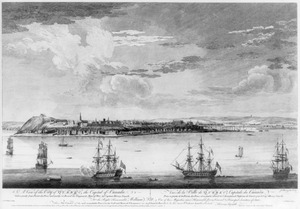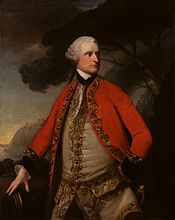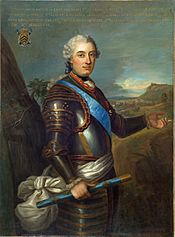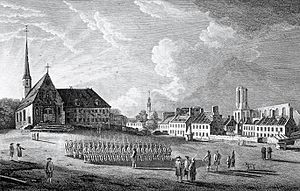Siege of Quebec (1760) facts for kids
Quick facts for kids Siege of Quebec |
|||||||
|---|---|---|---|---|---|---|---|
| Part of Seven Years' War | |||||||
 A view of Quebec being relieved by the Royal Navy. Print by Captain Harvey Smith on board HMS Vanguard |
|||||||
|
|||||||
| Belligerents | |||||||
| Commanders and leaders | |||||||
| Strength | |||||||
| ~6,000 150 guns 3 ships |
3,500 regulars 3,500 militia and natives 132 guns 6 ships |
||||||
| Casualties and losses | |||||||
| 30 killed or wounded Unknown to disease Naval action 1 Frigate wrecked |
206–350 killed or wounded 300–400 captured 44 guns captured All stores captured Naval action 6 ships captured or destroyed |
||||||
The Siege of Quebec was a time when the French tried to take back Quebec City from the British. The British had captured Quebec the year before, in 1759. This siege happened from April 29 to May 15, 1760.
The French commander, Francis de Gaston, Chevalier de Lévis, had to give up the siege. This happened when British ships arrived to help the city. After this, the British were able to capture Montreal a few months later. This meant the British had taken over all of Canada. This was later made official by the Treaty of Paris.
Contents
Why the Siege Happened: Background Story
In 1759, a British army led by James Wolfe sailed up the Saint Lawrence River. They surrounded Quebec City. After some fighting, Wolfe's army defeated the French army. This happened at the Battle of the Plains of Abraham on September 13, 1759.
The French commander, Louis-Joseph de Montcalm, died in the battle. The French armies then left Quebec, even though they had more soldiers. This left the city's defenders alone. Quebec City surrendered a few days later. British forces, led by James Murray, marched in and took control.
The French troops who retreated gathered near the Jacques-Cartier River. Francis de Gaston, Chevalier de Lévis took command of them. He wanted to take Quebec back right away. But he soon realized it was not possible. He decided to wait until the next year.
During the winter, Lévis's forces stayed near the Jacques-Cartier River. Even so, rumors spread in Quebec that a big French attack was coming. Lévis refused a suggestion from Murray for a winter truce (a stop to fighting). French patrols kept active. They even set up a position near Quebec until the British captured it. The British used snow shoes in a surprise attack.
Lévis got ready for his attack during the winter. He sent a message to Paris in October 1759. He asked for more soldiers, cannons, and supplies for Quebec. He wanted them to arrive as soon as the ice melted on the St. Lawrence River.
On April 20, Lévis's army left Montreal. They reached the village of Sainte-Foy by April 27. He had about 7,000 troops. About half were regular French soldiers. The rest were Canadian militia and Native allies. He also had twelve cannons.
Some of the British soldiers who captured Quebec had left with their ships. This left Murray with about 7,000 troops to defend the city. But many of these soldiers were sick or had died. Murray had only about 4,000 men ready to fight.
Murray learned about the French army's approach on April 27. This meant Lévis's surprise plan failed. Murray decided to march his army out of the city. He took a strong defensive spot. He hoped Lévis would attack him. This also gave Murray time to bring back his small groups of soldiers from outside the city.
Lévis chose not to attack Murray there. He felt the battlefield was not right for his plans. Instead, during the night, he moved his army to go around Murray's side. He used the woods for cover. Murray then moved his army back to a new spot. This was near where the Battle of the Plains of Abraham had been fought.
Murray decided to fight outside the city instead of staying inside. This was a risky choice. He thought his small army was used to beating the French. He also worried his forces could not last long in a siege. Murray had 3,800 troops ready to fight. This was almost every soldier in Quebec who was well enough. Lévis had a similar number of men ready, with more on the way.
The Battle of Sainte-Foy: A Bloody Fight

Lévis did not expect the British to fight the next day. He was surprised to see them. The battle started when Murray saw that the main French army was still marching. They were not yet ready for battle. The British quickly decided to attack.
Their advance was slow because of the ground. It was a mix of melting snow and mud. By the time the two armies met, the French were ready. At first, the British did well. They pushed back the French from their strong points. This caused some panic among the French.
The British kept pushing forward. They then met the main French army led by Lévis. After about an hour of close fighting, the British sides began to weaken. Murray ordered his troops to retreat. The French then won the battle. They captured the cannons the British had left behind.
This battle was even bloodier than the one a year before. Lévis lost 833 soldiers killed or wounded. The British under Murray lost 1,088 soldiers. This was almost one-third of his army.
Murray saw that he could not win the battle. He led his remaining forces back into Quebec City. He prepared to defend the city. He hoped that help would arrive up the Saint Lawrence River. Lévis had similar hopes. He brought up the rest of his forces. He began to get ready to surround the city. The cannons captured from the British were added to the French guns from Montreal.
The Siege Begins: Waiting for Help
On April 29, the day after the battle, the siege began. Lévis had not planned to besiege Quebec. He had to wait for more soldiers from France. So, he chose not to attack right away. Lévis's troops were very tired. He was also unsure about how well some of his militia would fight.
Instead, he took over the hospital outside the city walls. He began to bring up his cannons. Lévis refused to fire any cannons until he had forty guns ready. He wanted to make a very strong attack with all of them at once.
Inside Quebec: British Challenges
Meanwhile, Murray made plans. If the city fell to the French, he would go to the Île d'Orléans to the east. He would wait there for more soldiers to arrive. As the French built their siege works, the British soldiers' spirits dropped. There were problems with discipline.
Murray ordered strict punishments to keep order. One man was hanged for drinking problems. All the alcohol in the Lower Town was poured out or destroyed. Even so, the British soon began to fire accurately at the French siege works. By May 1, order and hope were back in Murray's army.
The city's defenses had been badly damaged by the previous year's attack. Some even suggested destroying the walls and leaving the city after it was captured. Instead, workers tried to rebuild the defenses. Murray also built defenses outside the city walls. The weak defenses made him decide to fight the French outside the city. There were also so few men that British officers helped pull cannons into the Lower Town.
Murray was worried that the local people would cause more problems. He tried to be kind to them. He asked them to give up their weapons and promise loyalty to King George II. This plan generally worked. But most people hoped the French would return. Murray had already sent away some people from the city. They were thought to be giving information to the French or encouraging British soldiers to leave. On May 2, Murray ordered the few remaining people to leave within three days.
A Standstill: Who Will Get Help First?
As time passed, it became clear that neither side could win easily. The French cannons were not strong enough to break down the city's defenses. The British were not strong enough to march out and defeat the larger French army.
The two commanders even exchanged small gifts of food. Lévis sent spruce beer and partridges. Murray sent Cheshire cheese. Victory would go to whoever's ships arrived first with more soldiers.
Lévis hoped that more soldiers would arrive from France. This would make his army stronger and allow him to take the city. In France, there was a debate about where to send soldiers. The French first minister, the Duc de Choiseul, thought fighting in Europe was more important. He planned a big attack in Germany.
The French hoped that if they won a big victory in Germany, they could trade it for Canada later. Also, the British navy had badly beaten the French navy the year before. French ports were often blocked. This meant their navy could barely work. To show Canadians they were not forgotten, a small group of supply ships was sent. They carried 400 soldiers. This was far less than Lévis needed. Only one frigate could be sent as an escort. Even this small help was reduced. British forces captured three of the supply ships after they left Bordeaux in early April.
Help Arrives: HMS Lowestoffe
When the British fleet sailed away the year before, Admiral Saunders had sent some ships to Halifax. They were ordered to return to Quebec as soon as the ice melted.
On May 9, a ship arrived near Pointe-Lévis. The French shouted Vive Le Roi (Long Live the King). They thought the ship was theirs. The British were worried. But the ship was HMS Lowestoffe. It was a 28-gun frigate from a group of ships led by Lord Colville. They were just outside the Saint Lawrence River.
A twenty-one-gun salute and the raising of the Union flag turned British fears into sudden joy. Lévis and the French were very upset. They knew Quebec had to be attacked quickly before the main British force arrived. Murray learned from Lowestoffe's captain that Colville's ships were coming down the Saint Lawrence. James Cook had mapped the river the year before, making it easier to navigate.
The Cannon Battle: British Firepower
Two days later, on May 11, the French cannons finally opened fire on Quebec's walls. The city walls were not built to handle heavy cannonballs. Both sides fired at each other until nightfall. A French boat and two floating gun platforms moved below Quebec. They planned to set up a mortar at Beauport.
Over the next few days, the cannon battle continued. Since taking the city, the British had built new openings in the walls. These allowed their gunners to fire back strongly at the French. One of Lévis's biggest problems was a lack of ammunition for his cannons. So, his rate of fire was slow. Lévis eventually ordered his men to fire only twenty rounds per gun each day.
In contrast, the British soon had many heavy guns firing on the French positions. They had unloaded many guns from their fleet before it sailed. They also had plenty of ammunition. Gunpowder was very common in the damaged town. With 150 guns now facing the French siege positions, the British could fire effectively. The British firing was so heavy that the French had to move their main camp about a mile away to protect it.
During the siege, the French suffered almost seven times more casualties than the British. It became so dangerous in the French trenches that Canadians had to be paid extra to work there. During this bombardment, the French suffered greatly. British shells alone killed 72 and wounded another 133.
British Help Arrives: The French Retreat
The French relief ships, led by François-Chenard Giraudais, had managed to get past the British blockade. They reached the mouth of the St. Lawrence River. But they found that the British ships had entered the river six days earlier. The French had arrived too late. They did not want to risk being trapped if another British fleet came up from behind. To avoid being caught, the French sadly decided to retreat.
Just after dark on May 15, the first of Commodore Colville's five warships appeared. They were below the Île d'Orléans. They carried two fresh British regiments from Louisbourg. The next morning, two more British frigates arrived. They were led by Commodore Robert Swanton. Swanton, following Murray's wishes, ordered HMS Diana and HMS Lowestoffe, soon followed by HMS Vanguard, to pass the town. They were to attack the French ships under Captain Jean Vauquelin in the river above.
Swanton forced the French to cut their anchor ropes. A running battle began. Swanton eventually drove Lévis's six smaller ships aground. British troops then captured the men ashore. The frigates could then line up against the French trenches. They fired grape and round shot at them. This forced the French to abandon their trenches.
At the same time, Murray no longer worried about saving ammunition. He unleashed a huge amount of artillery fire against the French. He planned to attack the French siege positions the next morning. A total of 2,913 shots were fired by the British on this day alone. This was enough to drive the French from their trenches again. It was reported that the French only managed to fire four shells in that time.
French Retreat: The End of the Siege
The destruction of the French ships was a huge blow to Lévis's hopes. They held his food and ammunition. With the British firing knocking out his guns and causing many casualties, Lévis decided to wait for night before leaving. He quickly ended the siege. He left behind his sick and wounded soldiers, as well as his siege camp. He also ordered his artillery to be thrown down the cliff near Anse-au-Foulon. He told his troops to share out their remaining food.
At 10 PM, the army began its march. The cannons had already been sent ahead. Soldiers who had left Lévis's camp then told Murray that the French were fully retreating. All the British cannons then fired randomly through the darkness. They sent cannonballs bouncing over the Plains of Abraham, chasing the retreating French army.
Murray then marched out with five groups of soldiers. The special grenadier and light companies were to attack the French from behind. He pushed across the marsh to Ancienne-Lorette. But even though the British captured many French stragglers, they could not catch the main army. The French had already crossed the Cap-Rouge River. They stayed on the banks of this river.
The British navy grew stronger on May 18 with Lord Colville's ships arriving. Two days later, merchant ships carrying important supplies began to arrive. This marked the end of the French siege.
What Happened Next: British Control of Canada
British losses during the siege were only about thirty killed or wounded. But there were still about 1,000 soldiers sick from disease. For the French, losses were heavy. They lost 350 killed or wounded. Another 300 were captured after the British help arrived. Many of these were badly wounded and had to be left behind. The French also left behind huge amounts of food, ammunition, and other equipment. They had to retreat so quickly that Lévis did not disable many of his guns. The British captured 55 of them, including ten heavy mortars.
After failing to go up the St. Lawrence, the French relief convoy hid in the Restigouche River. There were still Acadian people loyal to France there. But the Royal Navy defeated them in the Battle of Restigouche two months later.
With Murray's forces much larger in Quebec, the city became a starting point for taking the rest of French Canada. The British planned to capture Montreal, the last major French stronghold. They would attack from three directions. Separate forces would advance from Lake Ontario and from upper New York along different rivers. James Murray led the third group of 4,000 men from Quebec. They moved down the St. Lawrence River towards the Island of Montreal from the east.
The French Governor, Marquis de Vaudreuil, saw that the British had too many soldiers. He ordered Lévis, who wanted to keep fighting, to surrender. On September 8, 1760, Montreal was given to the British. The British finished taking over Canada by capturing the remaining small French outposts.
Lévis was later exchanged for a British prisoner. He then served in later French wars in Europe. The French government hoped to make up for losing Canada by winning battles in Europe. But Anglo-German forces won many victories. Also, more French colonies, especially in the valuable West Indies, were lost. So, in the talks before the Treaty of Paris, France agreed to give Canada to the British forever. In return, they got back Guadeloupe and Martinique.
Quebec would face another siege in 1775. This was the third in sixteen years. It happened during the American War of Independence. American rebel forces tried to invade Canada. The attack failed. British ships arrived down the St. Lawrence the next spring. This forced the Americans to give up their attempt. It was very similar to the relief of 1760.





